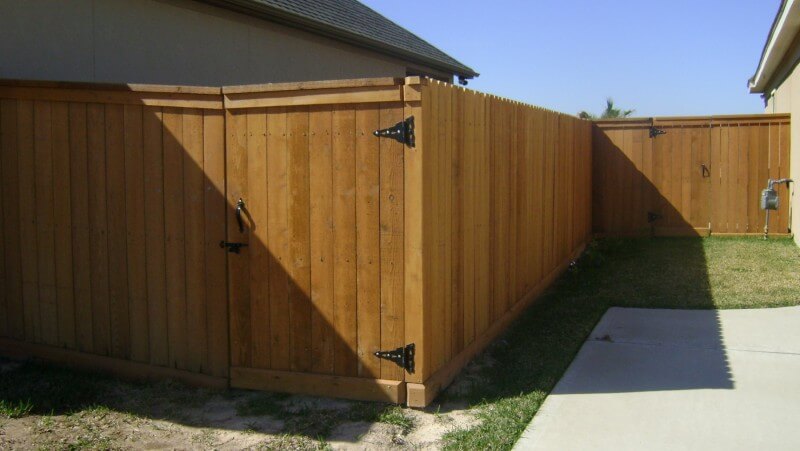10 Common Fence Repair Problems: Best Solutions
We’ve seen nearly every type of fence repair challenge in our years of professional installation and maintenance. From rotting posts that compromise structural integrity to storm damage that leaves sections completely destroyed, fence problems can quickly escalate if left unaddressed. Let’s explore the most common fence repair issues we encounter and the proven solutions that’ll help you maintain your fence’s strength, appearance, and longevity for years to come.

Key Points on Fence Repair
- Rotting wooden posts and rails caused by moisture damage weaken the fence’s structural integrity and require replacement.
- Sagging gates and misaligned hinges result from loose hardware and improper weight distribution over time.
- Poor drainage around fence posts leads to soil erosion and unstable foundation issues.
- Warped or split wooden boards develop from weather exposure and inadequate protective treatments.
- Loose or missing fasteners compromise fence stability and need regular inspection and replacement.
Rotting Wooden Posts and Rails
While wooden fences provide excellent curb appeal, rotting posts and rails present serious structural hazards that we can’t ignore. Once moisture penetrates untreated wood or finds its way into existing cracks, decay quickly compromises the fence’s integrity.
We typically spot this deterioration near ground level, where posts contact soil, and at rail-to-post connections.
For fence repair on rotting components, we’ll need to assess the damage extent. If rot affects less than 20% of a post or rail, we can treat the area with wood hardener and epoxy filler. However, when rot exceeds this threshold, we must replace the affected pieces entirely.
During replacement, we’ll use pressure-treated lumber and guarantee proper drainage around posts by adding gravel backfill and sloping the soil away from the wood.
Regular fence inspection and maintenance helps identify potential rot issues before they become severe structural problems.
Loose or Missing Hardware
Since hardware components provide critical structural connections throughout fence assemblies, loose or missing fasteners can quickly lead to fence instability and failure. We commonly see screws, nails, and bolts working loose from weather exposure, ground movement, and daily wear – especially at gate hinges and post connections.
For fence repair on these issues. we’ll start by first inspecting all hardware points, marking any compromised locations. As part of the fence repair we’ll replace damaged or rusted fasteners with corrosion-resistant alternatives, properly sized for each application. For loose connections, we can add lock washers or thread-locking compounds to prevent future loosening.
When we encounter stripped screw holes, we’ll fill them with wood epoxy or shift slightly to create new anchor points. Regular hardware checks should become part of our fence maintenance routine to catch problems early. According to surveys, pressure-treated lumber provides superior protection against weathering and decay in fence construction.
Storm and Wind Damage
Severe storms and high winds pose major threats to fence stability, even with properly secured hardware. We often see panels torn loose, posts uprooted, and rails snapped from intense weather conditions. These damages typically occur when wind forces exceed the structural capacity of fence materials.
To protect against storm damage, we recommend installing wind braces at strategic points and ensuring proper post depth – at least one-third of the fence height underground. Let’s reinforce vulnerable sections with additional concrete footings and diagonal supports.
When repairing storm-damaged fences, we’ll need to assess the full extent of structural compromise, as damage often extends beyond visible areas. It’s essential to replace warped boards, straighten bent posts, and verify foundation integrity before completing repairs. Wood fence construction requires special attention during repairs to maintain the uniform, alternating picket pattern that enhances curb appeal.
Rust and Corrosion in Metal Fencing
When we’re dealing with fence repair for rust on metal fencing, it’s paramount to address the problem quickly before it compromises the entire structure. We’ll need to remove all loose rust with a wire brush, treat any exposed metal with a rust converter, and apply a rust-inhibiting primer followed by exterior metal paint. Let’s explore the most effective rust treatments and preventive measures we can use to protect our metal fencing investment. Aluminum fences provide excellent resistance to corrosion and require minimal maintenance, making them ideal for coastal environments.
Preventing Further Rust Damage
To protect metal fencing from ongoing rust damage, we’ll need to implement several preventive measures that target both existing corrosion and potential future deterioration. Let’s focus on proven fence repair strategies that will extend your fence’s lifespan and maintain its structural integrity.
Apply a rust converter to chemically transform existing rust into a stable, paintable surface, then seal with a zinc-rich primer
Install sacrificial zinc anodes at key points along the fence to draw corrosion away from the main structure
Schedule bi-annual inspections to catch and address early signs of rust formation, particularly at joints and ground contact points
Maintain proper drainage around fence posts and apply water-resistant coatings that safeguard the metal’s surface
Together, we’ll guarantee your fence remains protected against rust’s destructive effects.
Best Rust Treatment Methods
Since rust formation can quickly compromise a metal fence’s structural integrity, choosing the right treatment method is crucial for effective restoration. We’ll examine proven techniques that deliver lasting results for your fence repair investment.
| Treatment Method | Best Application |
|---|---|
| Wire Brushing + Rust Converter | Surface-level rust spots |
| Sandblasting | Extensive rust coverage |
| Chemical Rust Removers | Hard-to-reach areas |
For the best results, we need to match the treatment method to the rust severity. Let’s start with mechanical removal using wire brushes for light surface rust, followed by a rust converter application. For heavily corroded sections, sandblasting proves most effective, though it requires professional equipment. In tight spots or ornamental details, chemical rust removers work best, penetrating deep into affected areas while preserving the metal’s structural properties.
Sagging Gates and Misaligned Hinges
We’ll examine how improper weight distribution across gate panels creates stress on hinges and leads to sagging that worsens over time. Common issues include loose or corroded hinge hardware that fails to properly support the gate’s mass, causing misalignment and dragging against the ground.
The root of these problems often traces back to inadequate post support, where posts weren’t properly set or have shifted in the soil, compromising the entire gate assembly’s structural integrity. Installing a metal gate frame can prevent sagging issues and provide better long-term stability for the structure.
Fence Repair – Gate Weight Distribution Issues
Whether your gate has gradually drooped over time or suddenly started scraping the ground, weight distribution problems can severely impact your fence’s functionality and appearance. We’ve found that improper weight balance often stems from structural issues that worsen with daily use and weather exposure.
Let’s address the most common weight distribution challenges and their solutions for this fence repair:
- Uneven load stress on hinges causing metal fatigue and misalignment
- Post settling that shifts the gate’s center of gravity
- Hardware loosening from repeated opening and closing cycles
- Additional weight from modifications like decorative elements or locks
We’ll need to assess your gate’s specific issues to determine the best fix. Sometimes it’s as simple as adjusting the hinges, while other cases might require reinforcing the frame or replacing support posts to restore proper weight distribution.
Loose Hinge Hardware Problems
After years of regular gate operation, loose hinge hardware often emerges as a primary cause of sagging gates and misalignment issues. When screws and bolts gradually loosen, the gate’s weight distribution shifts, creating stress on the remaining fasteners and frame components.
We’ll need to address this problem systematically for this type of fence repair. First, let’s check all hinge mounting points and tighten any loose hardware. If the screw holes have become stripped or enlarged, we can repair them by filling them with wood epoxy or installing larger screws. For metal posts, we’ll want to replace any worn bolts and add lock washers to prevent future loosening.
In cases where the hinges themselves have become bent or damaged, we’ll replace them with heavy-duty versions rated for your gate’s weight and usage patterns.
Post Support Weaknesses
Failing post support represents one of the most serious structural issues affecting gate performance, since it compromises the entire fence system’s stability. We’ve seen how deteriorating post foundations can lead to misaligned gates, uneven gaps, and compromised security. That’s why we need to address post support problems quickly before they worsen.
Here’s what we typically check when diagnosing post support issues:
- Soil composition and drainage around the post base
- Concrete footer depth and structural integrity
- Post material condition, especially at ground level
- Load distribution patterns on gate posts
When we encounter weak post support, we’ll often need to excavate around the affected posts, assess structural damage, and either reinforce the existing foundation or completely replace the post system. Sometimes we’ll recommend upgrading to deeper footings or larger-diameter posts for improved stability.
Ground Erosion Around Fence Posts
Ground erosion poses a serious threat to fence post stability, gradually weakening the foundation that keeps your fence upright and secure. We often see soil washing away from posts after heavy rains or due to improper drainage, creating voids that compromise structural integrity. Concrete post installation provides critical stability against ground erosion and prevents soil softening during wet conditions.
| Erosion Sign | Recommended Action |
|---|---|
| Exposed Post Base | Add compacted fill soil |
| Surface Runoff | Install drainage diversion |
| Soil Depression | Apply gravel backfill |
| Post Movement | Reset with concrete footer |
| Pooling Water | Create slope grade away |
To prevent further deterioration, we need to address erosion issues promptly. Let’s implement proper grading techniques around posts, install French drains where needed, and use erosion control materials like crushed stone or landscape fabric. For severe cases, we’ll need to excavate around affected posts, add proper fill material, and guarantee adequate compaction to restore stability.
Warped or Split Wooden Boards
While fence post stability forms the foundation, wooden boards often face their own set of challenges. We regularly see warping and splitting in wooden fence boards due to moisture fluctuations and sun exposure. These issues can compromise both aesthetics and structural integrity, but we’ve got proven solutions to address them.
Replace severely warped boards immediately to prevent strain on adjacent pickets and maintain proper spacing. Install boards with proper grain orientation – crown facing outward – to minimize future warping. Use water-resistant wood treatments and sealants every 2-3 years to protect against moisture damage. Add additional fasteners to stabilize split boards, or sister them with supporting boards when complete replacement isn’t necessary. Regular stain application helps prevent moisture absorption while enhancing your fence’s appearance and longevity.
Let’s keep our fences strong by addressing board issues promptly with these industry-tested repair methods.
Chain Link Fabric Damage
Chain link fences commonly suffer from fabric damage that manifests as rust spots, breaks in the mesh, or bent sections from impacts. We often encounter these issues when inspecting residential and commercial properties, particularly in areas with harsh weather conditions or high traffic.
To address fabric damage, we’ll need to assess whether a repair or replacement is warranted. For minor rust spots, we can wire brush the affected areas and apply rust-inhibiting primer followed by exterior-grade paint.
When dealing with broken mesh sections, we can weave in replacement fabric using special tension bars and wire ties. For bent sections, we’ll straighten the metal using fence pliers if possible, but severely damaged sections may require cutting out and splicing in new fabric segments.
Galvanized steel mesh provides excellent durability and weather resistance, making it the most popular choice for chain link fence repairs.
Pest and Insect Infestations
Despite regular maintenance, wooden fence posts and rails can become vulnerable to various pest infestations, including termites, carpenter ants, and wood-boring beetles. We’ve found that early detection and intervention are essential to preventing structural damage and costly repairs.
Let’s examine the most effective ways to protect our fences from these destructive pests.
- Treat fence posts with copper naphthenate or borate-based preservatives to create a protective barrier
- Install metal barriers or mesh around the base of posts to prevent termite access
- Schedule regular inspections, focusing on areas where wood contacts soil
- Apply environmentally-safe insecticides specifically formulated for wood-destroying organisms
If we notice sawdust, small holes, or hollow-sounding wood, it’s time to take immediate action. Professional pest control services can help eliminate existing infestations while we implement preventive measures to protect our investment.
Annual sealing and staining provides crucial protection against insect infestations and helps maintain the structural integrity of cedar fences.
Frost Heave and Foundation Issues
When winter temperatures fluctuate between freezing and thawing, our fence posts can suffer from frost heave – a destructive process that forces posts upward as moisture in the soil expands and contracts. We’ll often notice misaligned gates, wobbly posts, and uneven fence sections as telltale signs of frost damage.
To prevent frost heave, we need to guarantee posts are set below the frost line – typically 36 to 48 inches deep in most regions. We can also add gravel at the base of posts for improved drainage and install concrete footings that bell out at the bottom.
For existing fences, we might need to reset affected posts, using a mix of fast-setting concrete and crushed stone to create a stable foundation that’s better equipped to handle seasonal ground movement. Clay-based soils retain more moisture and can increase the risk of frost heave damage.
Frequently Asked Questions
How Often Should I Repaint or Stain My Wooden Fence?
We recommend staining or painting your wooden fence every 2-3 years for ideal protection. Let’s maintain it more frequently in harsh climates or when you notice fading, peeling, or weathering.
What Permits Do I Need Before Installing a New Fence?
We’ll need to check with our local building department for height restrictions, property line regulations, and zoning permits. Don’t forget HOA approval if you’re in a managed community.
Can I Install a Fence Directly on My Property Line?
We recommend installing your fence slightly inside your property line to avoid disputes. Let’s verify boundary lines through a survey and check local setback requirements before proceeding with installation.
What’s the Average Lifespan of Different Types of Fencing Materials?
We’ll typically see chain-link fences last 15-20 years, wood fencing 10-15 years, vinyl 20-30 years, and wrought iron 20+ years when properly maintained with regular inspections and protective treatments.
How Much Space Should I Leave Between Fence Posts for Proper Installation?
We recommend spacing fence posts 6 to 8 feet apart for most residential fencing. For heavier gates or challenging terrain, let’s reduce spacing to 4 feet for extra stability and support.
Takeaway
We’ve examined the key issues that plague residential fencing, from moisture-damaged posts to foundation instability. By implementing proper drainage solutions, using galvanized hardware, and maintaining regular inspection schedules, we’ll prevent most common fence problems before they escalate. Let’s focus on preventative maintenance, quality materials, and professional installation techniques to guarantee our fencing investments remain secure and functional for years to come.








